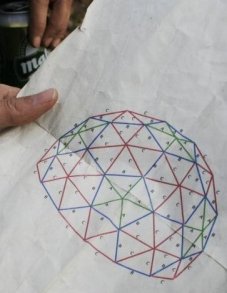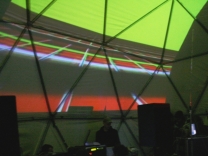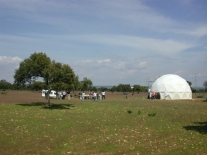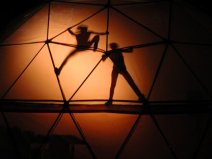

Raising the dome in Valdecaballeros (photos: Alex Muñoz)
Emergent Geographies
La produccion del espacio, la conceptualizacion de la produccion del espacio pone en juicio dos cosas: 1. LA DIMENSION MATERIAL del OBJETO y 2. el modo de hacer que se genera como un despliegue de las practicas del sujeto sobre el sentido de la forma. Apartir de estas lecturas y las dimensiones culturales de hibridizacion socio-urbana, los procesos de agenciamiento politicos y su representacion o la falta de representatividad publica, a su vez la crsis del lugar como representacion o como constructura de la nocion ciudadana, instala de manera categorica no solo un tipo de huella, sino un tipo de pulsion sobre las estrategias, tacticas, operaciones y logicoas urbanas contemporaneas.
Un ejemplo de lo anterior, es posible verlo en HACKITECTURA y Straddle-3 architecture/new media group. Estos son grupos que establcen una produccion de forma relacional donde la cooperatividad, la estrechez del marco de gestion y produccion, inscriben mediante los procesos de combinacion urbana, y me refiero a autogestion y sustentabilidad urbana, junto con el surgimiento de nuevas tecnologias abren, solapan y reformulan finalmente los ritmos, flujos, y constructos de orden posicional de la sociedad, el tiempo y los espacios de consumo como ejemplos de habitabilidad post-urbana. Estas cualidades son dimensionadas en este articulo de BRIAN HOLMES en GEOGRAFIAS EMERGENTES, espacios de territorios multiescalares pero no por los saltos ornamentales de sus formas sino por la interrogante de las relaciones sociales y los espacios que se producen.
------------------
Architecture in the restricted sense is the technical art of construction, whose finished objects are the buildings, monuments and plazas that trace out the plan of a city. But architecture in a larger, never-finished sense refers to the production of space itself: the deployment of all the conduits, containers and machines that open up or close off the possible lives of human beings. Architecture in this sense is the formal and material texture of a society in time, its constructed, artificial texture, inseparable from the flows, crossings, combinations, passions and explosions whose rhythms make up the pulse of social life: the specific affects of the world, crisscrossed by so many converging and diverging worlds. The strategy of the Spanish group Hackitectura is to produce, not finished objects, but interventions constructed and deconstructed on the spot by multiple groups and agencies - experimental events whose traces take the form of relational networks, cooperative forces gathering strength for the transformation of the pulse. Maybe nowhere has this strategy become so clear as in the countryside of Extremadura in southwestern Spain, in an isolated region that the locals call “Siberia.” At the unraveling edge of contemporary urban textures, the urge to experiment has led to some inspiring results - not in the form of buildings left to the past, but as a foretaste of what could be the future.
Here in Siberian Extremadura, for an event entitled “Emergent Geographies,” Hackitectura and the Straddle-3 architecture/new media group have set up a semi-transparent geodesic dome about ten yards in diameter, on a farmer’s field surrounded by grazing sheep. It’s half shelter, half screen - an evanescent bubble of technical know-how and artistic creation, located right next to the hulking concrete ruin of the Valdecaballeros nuclear power plant. They have installed computer equipment in a semi-circle like a mock control room, and filled the interior and the surrounding grounds with hackers, dancers, musicians, architects, free-software enthusiasts, elements of the regional government and whoever else wanted to come along for a workshop and a party beneath the sun, the rain and the stars.
The place itself was the strange attractor, at once Arcadia and lingering nightmare. The construction of the two reactors, launched under Franco, was finally halted in the early 1980s by a popular movement, leaving only massive buildings closed to the light, or maybe the tombs of an old dream gone wrong. The empty shell is surrounded with rusting wire fences, still vibrating 24 hours a day with the static hum of transformers rerouting current across the national grid - the only functioning part of a plan that led to nowhere. By opening up a collaboration with the Linex free software program of the Extremadura regional government, and by locating this utopian collaboration beneath the shadow of a failed modernity, “Emergent Geographies” tries to replay the choices that led to the production of industrial space in the 20th century. But what is that space, and how does it appear in 2007?
Atomic to the Core
The power plant, considered private property, is situated next to one of the region’s man-made lakes, dammed up as part of the development programs conducted under Franco. It is closed off to the public with warnings of fines and criminal consequences; but there was never any fissile material here, so that prohibition is not taken too seriously. Multiple holes cut in the chain link fences offer access to the building, which is itself unlocked. The inside is a labyrinth of vast, windowless spaces, traversed by blind corridors with stairwells leading down to flooded basements. The rooms and hallways echo with dripping water, footfalls, creaking metal and unidentifiable noises amplified by gaping emptiness. To approach this western European “heart of darkness” is to come face-to-face with a massive, inadvertent monument to the Faustian pact that bound entire populations to the industrial State. The social space of the twentieth century, with its highly extended networks of energy transmission, circulation and exchange, and its ultra-concentrated hubs of industrial manufacture and political-economic control, has been physically produced by this Faustian pact, whose continuity today is symbolized by the cryptic reality of the entombed reactors.
The essence of the bargain was to offer inexhaustible riches torn from nature by the machinery of technoscience, at the price of an authoritarian discipline that steeled its operative agents against the threat of breakdown, conflict and toxic collapse - an ever-present, invisible, invasive and potentially infinite danger. To meet it, society had to forge a new kind of person, a literally atomized individual, able to maintain a quasi-military discipline during working hours before dissolving into the pleasures of consumption in the evening and on weekends. The relentless executives of today’s imperial corporations, firmly backed by the bureaucrats and soldiers of the nation-states, are the human results of this technological challenge thrown down in the face of the body’s ordinary frailty. In this sense the current war in Iraq, a corporate war for oil, is atomic to the core.
On our way to the illuminated dome of “Emergent Geographies” for an evening concert, we ran up against the legacy of this Faustian bargain in the person of a National Guardsman who stopped our car, alone of all those passing by, for a scrupulous control of our papers. He explained that he was not part of the “local operation” (i.e. the municipality and provincial government), that he was assigned here by the Spanish State, and that he had not received the necessary official information about this event, whose program he had nonetheless studied in detail - to the point where he could recite the names and times of the screenings, conferences and performances that were to take place that evening. For a long time he went on talking at us in strange, robotic sentences. We thought for a moment about inviting him to come experience the event, but given the range of things he might consider illegal, that didn’t seem like such a good idea.
The truth that came through this man’s voice, and that can be seen in multiple forms throughout the contemporary societies, is that the pact of industrial progress at all costs has never been broken (for example, eight nuclear reactors are still furnishing Spain with their dangerous surfeit of electrical energy). In the 1970s when protests rose against Valdecaballeros and other megaprojects around the world, the Faustian bargain was refused and delegitimated by fractions of the national populations; but its basic elements were retained and amplified beneath the cover of an expanding culture of hyperconsumption, which helps us forget the basic fragility of the world. Curiously, yet also predictably, a majority of the adult inhabitants of the local area, interviewed in the course of the cultural project, were nostalgic for the promise of jobs and economic benefits offered by the power plant. When interviewed about what it could become today, they suggested its conversion into a grandiose commercial mall offering the good things you see on TV. But the children of the village, when given a floor plan to fill in with sketches of other uses, showed a wider range of imagination: a beach, a swimming pool, a “factory for making money” (take that literally!), living spaces, playgrounds, indoor parks…
Fantastic Voyage
If you like, “Emergent Geographies” could be seen as an adult reply to the children sketching their dreams into the toxic plans of modern industrial space. Only here, the expression of luxuriant fantasy takes on far more complex social and machinic forms, the fruit of a constructive effort that seeks to denormalize subjectivity and open up the possibilities for a different occupation of the territory. The latter is itself conceived as a second nature: “The landscape would be, on the one hand, the basic infrastructure of the territory, and on the other, global information in the raw,” writes Sergio Moreno (aka Chaser). Atop the landscape appear public spaces, “those spaces where a minimum of information treatment changes the landscape into a place of encounter, work and expression, as the fruit of an intentional relation between individuals and machines.” These in their turn meld into the global city, “where collective knowledge condenses into an awareness of the territory.” Through the ad hoc creation of informational public spaces, Hackitectura’s project/desire is to help precipitate precipitate a global consciousness of the territory that humanity has produced, a consciousness that they also call the multitude.
Such a vision is clearly utopian, which doesn’t mean it’s naive: everyone involved in this project constantly theorizes, and also suffers, the alienation of capitalism and its atomic individualism. To go on quoting Chaser, they conceive the really existing form of networked social relations as a “grammar” that articulates “an inexhaustible fountainhead of production, even though its habitual uses are hierarchical, closed and one-directional.” But this zero-sum game gets much more interesting when some of the older kids start to change the rules, to rewrite the operational codes and invoke new relational patterns from the existing territorial infrastructure. That’s essentially what has been done in Extremadura: an attempt at rewriting the technological present, an embodied exercise in social science fiction.
All this began just a few years ago, around the turn of the century, with a rising wave of social movements, utopian hopes around the new technologies, and networked forms of embodying the need for another life. Groups of activists in the Seville and Malaga areas organized counter-summits and local social forums, bringing the alternative cultures of squatted houses and hacker collectives onto the public stage, with punctual acts of radical dissent and longer-term projects of solidarity with the migrants ceaselessly crossing the Straits of Gibralter. In June 2003, Indymedia del Estrecho was founded, as a regional, transborder node of the global network, focusing on the “Madiaq Territory” that extends on either side of the western Mediterranean. Hackitectura itself came into view by coordinating work on a map of this increasingly militarized territory, which exemplifies the realities of imperial control even while it is continually traversed by the multitudes. The map was carried out by a constellation of groups and individuals in the context of the first Fadaiat encounter in a medieval castle in the town of Tarifa, the southernmost point of Europe, just across the Strait from Tangier, in 2004. There a quite complex technical and legal effort was made to establish a wifi connection across the Straits, seeking that elusive goal of collaboration across all borders. The event was held again in 2005: long summer days and nights with lectures, debates, workshops and projections, organized with Florian Schneider and the Borderline Academy. Already there was a collaboration with the “Fortresses of Europe”: experimental media centers in Novi Sad, Serbia, and Karosta, Latvia, launching collaborations with further points on the rhizomatic map of the connected multitude.
But one thing you didn’t find the classic beachside town of Tarifa is exactly what surrounds me as I write: a mixed crowd, local kids and curious adults from the village, brought by educational programs and reassured by the collaboration with public officials, mainly the Linex people who introduced free software as a cheaper and more interesting solution for network access in cash-strapped Extremadura. Paradoxically it is in the more isolated corners of the world, where the televised dream of progress underscores the reality of isolation, that a hi-tech media camp with a bunch of crazy hackers and artists can make the most interesting difference.
What could overcome the toxic priorities of modern industrial space? Everyone here speaks of ecology and new technology, but the phrase that comes to my mind is an economy of desire…
TO BE CONTINUED… (the party’s a little too intense to go on writing)


Clausthome concert (photos: Nicholas Henninger)
brian holmes
http://brianholmes.wordpress.com
Jose Llano
Arquitecto, Diseñador de Delitos & Coreografo del Deseo
editor aparienciapublica
www.aparienciapublica.org
http://aparienciapublica
________________________________
AMERICA has a rest, where you want to be












No hay comentarios.:
Publicar un comentario